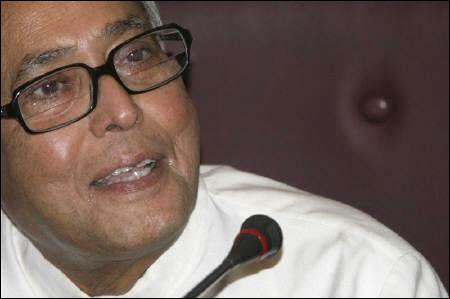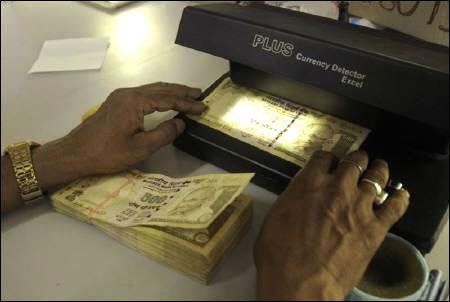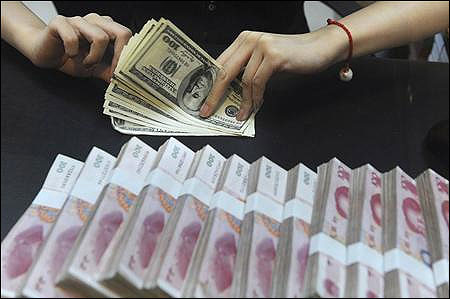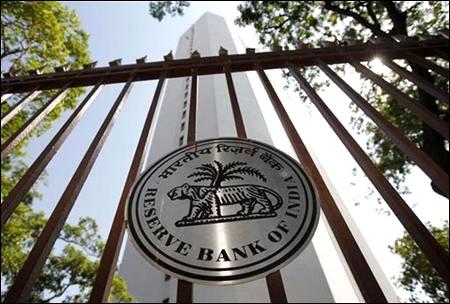Photographs: B Mathur/Reuters Vivek Kaul and Nupur Pavan Bang
Five things you did not hear the Finance Minister Pranab Mukherjee say in the budget speech.
"Statistics are like a bikini. What they reveal is suggestive, but what they conceal is vital," said Aaron Levenstein, an American professor of business management. And not Navjot Singh Sidhu as we Indians tend to believe.
The annual budget of the government of India is also like a bikini. A lot it is revealed about it through the budget speech made by the Finance Minister, but the vital aspects lay hidden in the budget document.
Here are five things you did not hear the finance minister Pranab Mukherjee say in the budget speech he made a few weeks back.
Click on NEXT for more...
Why the annual Budget is like a bikini
Photographs: Fayaz Kabli/Reuters
1. The government of India in the financial year 2011-2012 (i.e. the period between April 1, 2011 and March 31, 2012) spent 65% more than what it earned:
That the government spends more than it earns, we all know. This difference, known as the fiscal deficit, is expressed as percentage of the gross domestic product (GDP).
For the financial year 2011-2012, the fiscal deficit of the government of India stood at 5.9 per cent of GDP. But this number somehow does not convey the grimness of the scenario that the government of India is in.
The expenditure for the year 2011-2012 has been estimated to be at Rs 1,318,720 crore (Rs 13,187.2 billion). In comparison the government's income for the year is at Rs 7,96,740 crore (Rs 7,967.4 billion).
This works out to a difference or fiscal deficit of Rs 5,21,980 crore (Rs 5,219.8 billion). Hence in simple English the government spends 65.5 per cent more than what it earns.
When we compare the situation in this way we come to realize that the government is spending much more than what it earns. If you or me were to do that we would be in trouble pretty soon. The government as we shall see has a longer lifeline.
Click on NEXT for more...
Why the annual Budget is like a bikini
Photographs: Fayaz Kabli/Reuters
2. The fiscal deficit of the government of India has gone up by more than 300% in the last five years:
For the financial year 2007-2008 (i.e. the period between April 1,2007 and March 31, 2008) the fiscal deficit stood at Rs 1,26,912 crore (Rs 1269.12 billion), against Rs 5,21,980 crore (Rs 5,219.80 billion) for the financial year 2011-2012.
Now what does that tell you? In a time frame of five years the fiscal deficit has shot up by nearly 312 per cent.
During the same period the income earned by the government has gone up by only 36 per cent to Rs 7,96,740 crore (Rs 7,967.4 billion).
When expenditure is expanding nearly 9 times as fast as your income, it can't be a good thing. No wonder, the finance minister gave that piece of information a miss.
Click on NEXT for more...
Why the annual Budget is like a bikini
Photographs: Jayanta Dey/Reuters
3. The fiscal deficit target for the financial year 2012-2013 (i.e. the period between April 1, 2012 and March 31,2013) is likely to be missed:
When the finance Pranab Mukherjee gave his budget speech in February last year, he had set the fiscal deficit target for the financial year 2011-2012, at 4.6 per cent of GDP.
He missed his target by a huge margin when the real number came in at 5.9 per cent of GDP. The major reason for this was the fact that Mukherjee had underestimated the level of subsidies that the government would have to bear.
He had estimated the subsidies at Rs 1,43,750 crore (Rs 1,437.5 billion) but they ended up costing the government 50.5 per cent more at Rs 2,16,297 crore (Rs 2,162.97 billion). The finance minister had underestimating the subsidy level of the three main categories of food, fertilizer as well as oil.
This has been the case in the past as well. In 2010-2011 (i.e. the period between April 1, 2010 and March 31, 2011) he had estimated the oil subsidies to be at Rs 3,108 crore (Rs 31.8 billion).
They finally came in 20 times higher at Rs 62,301 crore (Rs 623.01 billion). Same was the case in the year 2009-2010 (i.e. the period between April 1, 2009 and March 31, 2010). The estimate was Rs 3,109 crore (Rs 31.09 billion). The real bill came in nearly eight times higher at Rs 25,257 crore (Rs 252.57 billion) (direct subsidies + oil bonds issued to the oil companies).
Similar underestimates have been made for the financial year 2012-2013, to project a fiscal deficit of 5.1 per cent of GDP. The total subsidies bill has been estimated to be at Rs 1,90,015 crore (Rs 1,900.15 billion) a good 12 per cent lower than the subsidy bill for the year 2011-2012.
The government has constantly underestimated the cost of subsidies and there is no reason to believe that it would not be the same for this year as well.
Oil prices are unlikely to go down, and inflation is also not seen slowing down. Hence it is most likely that the government will miss its fiscal deficit target for this year as well.
The only way to cut this bill is to cut the level of subsidies, and that is unlikely to happen. As a known stock bull said on TV the other day, even Saudi Arabia doesn't sell kerosene at the price at which we do. And that is why a lot of kerosene gets smuggled into neighbouring countries and is used to adulterate diesel and petrol.
Click on NEXT for more...
Why the annual Budget is like a bikini
Photographs: Jayanta Dey/Reuters
4. The government is in a huge debt trap:
The fiscal deficit target for the financial year 2012-2013 has been set at Rs 5,13,590 crore (Rs 5,135.9 billion). The government raises this money from the financial system by issuing bonds which pay interest and mature at various points of time.
Of this amount that the government will raise, it will spend Rs 3,19,759 crore (Rs 3,197.59 billion) to pay interest on the debt that it already has.
Rs 1,24,302 crore (Rs 1,243.02 billion) will be spent to payback the debt that was raised in the previous years and matures during the course of the year 2012-2013.
Hence a total of Rs 4,44,061 crore (Rs 4,440.61 billion) or a whopping 86.5 per cent of the fiscal deficit will be spent in paying interest on and paying off previously issued debt. What this means is that new debt is being issued to pay off old debt and pay interest on it.
The situation is similar to that of an individual who takes new loans to pay off older loans or rotates credit card debt across his various credit cards.
The government can keep doing this for a long period of time because in the worst possible scenario it can print money and repay the debts that have accumulated and in the process reduce the value of the domestic currency.
This is what many governments in the developed world are doing right now. You and I can't do this and ultimately will fall prey to debt collectors or will end up behind bars!
Click on NEXT for more...
Why the annual Budget is like a bikini
Photographs: Stringer/Reuters
5. Interest rates will continue to be high:
As explained above the government finances its fiscal deficit by issuing bonds on which it pays interest. Who buys these bonds? These bonds are primarily bought by banks which by law need to invest 24 per cent of their deposits in such bonds.
At the same time the government is also competing with private companies and you and I for this money. The banks have the option of lending their deposits to companies and also give it out to individuals in the form of car loans, home loans, credit cards, personal loans etc.
Hence the government has to offer a higher rate of interest on its bonds. Given this, the rate of interest charged by banks on all other forms of loans goes up because they are more risky than lending to the government.
Hence if the government is offering a rate of interest of 8 per cent on its bonds, then the banks are likely to charge more on all other forms of loans that they make. So the next time the finance minister talks about the interest rates going down, be skeptical.
The interest rates cannot go down as long as the fiscal deficit doesn't go down and that doesn't seem to be happening any time soon.
Vivek Kaul is a writer and can be reached at vivek.kaul@gmail.com. Nupur Pavan Bang is a Senior Researcher at the Centre for Investment, Indian School of Business and can be reached at npbang@gmail.com







article